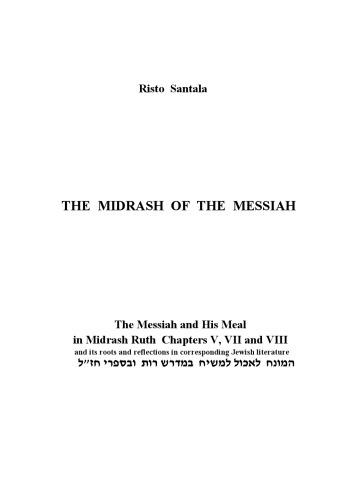The Midrash of the Messiah 1ST Edition by Risto Santala ISBN 9789529147809 9529147805
$50.00 Original price was: $50.00.$35.00Current price is: $35.00.
The Midrash of the Messiah 1ST Edition by Risto Santala- Ebook PDF Instant Download/Delivery: 9789529147809, 9529147805
Full download The Midrash of the Messiah 1ST Edition after payment

Product details:
ISBN 10: 9529147805
ISBN 13: 9789529147809
Author: Risto Santala
The Midrash of the Messiah by Risto Santala is a scholarly exploration of messianic themes within Jewish rabbinical literature, focusing particularly on Midrash Ruth. Published in 2003 by Keren Ahvah Meshihit, this 326-page work delves into the symbolic and theological significance of the Messianic banquet as portrayed in Jewish texts, drawing parallels to the Christian concept of the Holy Communion
Table of contents:
I INTRODUCTION
The formulation of the problem and its methodological aspects
II FUNDAMENTAL FACTORS IN MIDRASHIC LITERATURE
1. The concept of Midrash:
Midrash and its relation to Pesher and Targum
2. Midrash Ruth and its position in Midrashic literature
2,1 The early Midrashim
2,2 The middle Midrashic period
2,3 The later Midrashic period
3. The literary methods of Midrash:
3,1 Common Rabbinic regulations
3,2 The special characteristics of Midrash
4. Choosing a proper method for Jewish studies:
4,1 The characterization of Greek wisdom and Biblical thought by Thorleif Boman and Shalom Ben-Chorin
4,2 The topical method שטת המקום as expounded by Aristotle, Giovanni Battista Vico and Jacob Neusner
4,3 The present dilemma in Midrashic studies
4,4 Our methodological approach to Midrash Ruth
III. MIDRASH RUTH RABBAH
1. The various manuscripts and their literary evaluation
2. The content of Midrash Ruth Rabbah:
2.1 The content and the division of Midrash Ruth
2.2 The Book of Ruth and the Targum
2.3 Ruth Rabbah compared with other Midrash Rabbah collections
2.4 The moral conduct of the people of Israel in the dispersion
2.5 The national disappointment expressed in Midrash Ruth and its equivalents in Jewish sources
2.6 The national disappointment in the light of the Siddur
2.7 The psychological and symbolic message of Ruth Rabbah
2.8 The “hot potato”: Elisha Ben Abuyah
2.9 The Six parables of the King and their equivalents in the New Testament
2.10 The total lack of halakhic purification rules in Ruth Rabbah
IV. TRANSLATION OF THE “MESSIAH-PARASHIYOTH” IN MIDRASH RUTH RABBAH
The English text of Ruth Rabbah V,6; VII,2; and VIII,1 according to the standard Wilna edition
V. INTERTEXTUAL AND CONCEPTUAL ANALYSIS OF THE RESPECTIVE MESSIANIC PASSAGES
Specifications concerning Parashah V
1. The numerical pattern “six” (Shetin)
1.1 Seth and other Messianic allusions in the Book of Genesis
1.2 The logic of the numeral six
2. “Come here” “near to the kingdom”, come here, near the kingdom
3. “The bread of the kingdom”
4. “Vinegar” and sufferings Vinegar symbolizes suffering
4,1 The place of “vinegar and sufferings” as a whole
4,2 The message of the true vine
5. Does Isaiah 53 speak of the personality of the Messiah?
5,1 Isaiah 53 in the Talmud
5,2 Isaiah 53 in the Zohar tradition related to Midrash
5,3 Isaiah 53 in Jewish prayer literature
5.4 Reflections on Isaiah 53 in the Middle Ages
6. To be “satisfied” linked with “to eat in this world and in the Messianic age”, food for the days of the Messiah food for the future
6,1 A conceptual analysis of “eating to the Messiah”
6,2 The tradition of Elijah and the Messianic age
6,3 The fate of the Torah in the Messianic age
6.4 The interplay between above and below
7. The first and the last Redeemer
7,1 The Rabbinic exposition of these concepts
8. “The kingdom taken from him for a time”
8,1 The potential denial of the Messiah for a time
8,2 The potential second advent of the Messiah
8,3 The “kingdom”, one of the favorite concepts of Midrash Ruth
8,4 The heavenly “seat” in the light of Psalms 2 and 110
8,5 The vision of the kingdom in the Siddur
9. The “blessing in the stomach” of Ruth, the blessing in the stomach of that righteous woman
10. Recording of good deeds, Elijah writes and the Messiah and the Holy One seal our good deeds
10,1 Good deeds in the Jewish and Christian context
10,2 Elijah the celestial scribe
10,3 Elijah and the Messiah in the Jewish prayer book, the Siddur
10,4 Penuel, the Angel of the Lord, the Angel of the Covenant, the Prince of the Countenance and the Lord of the Covenant
10,5 The Messiah as the Prince of the Countenance and the Metatron in the Siddur
10,6 The heavenly scribe in the light of Talmudic literature
10,7 Why does Midrash Ruth deal with the disputation concerning the heavenly scribe?
Specifications concerning Parashah VII
1. A concealed solution to the Messianic mystery
2. The secret of the “closed Mem”
3. The Song of Songs as a key-text for Messianic interpretation
Specifications concerning Parashah VIII
1. The tainted descent of Ruth and the evil inclination in Jewish and Christian literature
1,1 The problem of free will and original sin
1,2 Some extracts concerning free will in Midrash Ruth and the New Testament
1,3 The evil inclination in the writings of Qumran
1,4 The evil inclination in the light of the Siddur
2. Discussion concerning Perez, Peretz and the origins of Messiah
3. The “ladders of princes and kings” ladders for presidents and ladders for kings
4. The genealogical tree of the Messiah linked with the New Testament
VI THE SAGES BEHIND THE MESSIANIC PARASHIYOTH IN MIDRASH RUTH
1. The Sages in the “Messiah-Parashiyoth”
2. The tradition of Midrash Ruth visualized in schemes
VII THE MESSIAH AND HIS MEAL IN RESPECTIVE JEWISH LITERATURE
1. The bridge to the relevant literature
1.1 Preliminary results of our intertextual approach
2. The Messianic meal in the Dead Sea Scrolls
2,1 The common characterization of the Qumran Scrolls in this context
2,2 The Messianic meal at Qumran and its special aspects
3. The Messianic meal in the New testament
3,1 The limits of our inspection
3,2 The historical background of the Passover meal
3,3 The message of the bread
3,4 The message of the wine
3,5 The eternal perspective in the Holy Communion
3,6 “The blessing of the song” and the “hallel”
4. The Didache and its Messianic banquet
4,1 The Didache as a bridge between Jewish and Christian thinking
4,2 The Didache as source material for the Holy Communion
5. The third meal in the tradition represented by the Zohar, the Talmud and the New Testament
5,1 The third meal and its specifications in the Zohar
5,2 The third meal in the tradition of the Talmud
5,3 The third meal reflected in the New Testament
6. The Messianic meal in the light of the Jewish prayer literature
6,1 The banquet of King David in the Siddur
VIII. CONCLUSIONS CONCERNING THE MESSIAH AND HIS MEAL IN ITS JEWISH FRAME OF REFERENCE
1. Conclusions concerning the method and content of our study
2. Specifications about the Messianic idea in Midrash Ruth
2.1 The enigma of Isaiah 53 in its Jewish frame of reference
2.2 The Messianic age and the Torah
2.3 The potential second advent of the Messiah
2.4 The enigma of the birth of the Messiah
2.5 Elijah and Metatron
2.6 The secret of “the closed Mem” in Isaiah 9:6
2.7 Good deeds and free will
2.8 The genealogy of the Messiah
3. New light on the Messianic meal
3.1 The “piece of bread” projected in old sources
3.2 The wine and its interpretations
3.3 The “hallel” linked with the eternal perspective
3.4 Other similar Messianic banquets in the old tradition
3.5 The special message of the so-called “third meal”
3.6 The holy banquet in Didache
3.7 The third meal in the book of Siddur
4. “What then shall we say?”
5. The scheme of the content and the roots of our study
People also search for:
the midrash of the messiah
a messiah
is the messiah in the torah
zohar messiah
x-men messiah trilogy
Tags: Risto Santala, The Midrash, the Messiah


